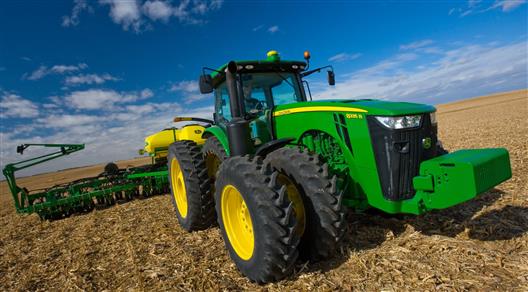Planting back on track in Craighead County
by May 2, 2018 9:00 pm 332 views

Tractors have been running round the clock since Sunday afternoon in Craighead County row crop fields as farmers try to get back on schedule after weeks of rain and cold temperatures hampered efforts, Craighead County extension agent Branon Thiesse told Talk Business & Politics. Rice and corn crops are the first to be planted, and he estimates at least 60% of the rice crop is in the ground and it should be finished within the next 10 days if weather conditions hold, he said.
“Our farmers are working fast and furious right now,” he said. “They’ve got people planting on 12-hour shifts. When one stops, the other one starts. I think we’re close to being caught up. It’s amazing what they can get done in such a short time.”
Corn is on the same track as rice, and farmers have started to plant peanuts, cotton, and soybeans. About 15% of the soybean crop has been planted, he said. Exact acreage amounts won’t be totaled until the planting season has ended, he said. Rice and corn are more cold temperature resistant. Cotton and soybeans produce better yields when the weather is slightly warmer. If the rice and corn crops aren’t in the ground by the second week in May, yields typically decline, he said.
The early planting season was plagued by wet, cold weather. Muddy fields prevented many seeds from being sown, he said. This last weekend the weather warmed and the wind started to blow, aiding the drying process, he said. It dried so quickly that a little rain right now may be needed to soften the ground, he said.
Rain could be on the way in the region later this week. The National Weather Service predicts there is a 50% chance of rain on Thursday (May 3) and a 40% chance on Friday (May 4) in the region.
Craighead County has an estimated 338,000 agricultural acres and soybeans are the dominant crop, according to the United States Department of Agriculture’s National Agricultural Statistics Service, or NASS. The number of acres fluctuates each year based on commodity prices, weather, ground conditions, and other factors, Thiesse said. In 2017, the county had 118,000 soybeans acres; it had 108,000 in 2016; about 140,000 in 2015; and 119,000 in 2014, according to NASS.
Rice and cotton typically vie for second and third in the county, Thiesse said. In 2017, the county had 60,000, followed by 74,000 acres in 2016. The county had 69,000 acres in 2015, and 72,000 in 2014, according to NASS. Cotton acre figures for 2017 were not available. In 2016, the county had 67,000 acres and it dropped to 30,000 acres in 2015. The dramatic change that year was due to low prices, Thiesse said. In 2014, the cotton acreage totaled 57,000 acres.
There are other row crops grown in the county such as peanuts and wheat. Peanuts are a relatively new crop and a lot of cotton farmers are using it as a rotational crop in their cotton fields, he said. Wheat is sparsely grown in Craighead County and its acres are not even tabulated on a county scale anymore, he added. Milo fields used to be abundant even just a few years ago, but now it’s rarely grown in the county.
Planting conditions for Arkansas Delta farmers may have improved, but access to international markets for their crops still remains uncertain. President Donald Trump has pursued a new North American Free Trade Agreement, NAFTA, since he took office and talks are ongoing. China and the U.S. have traded tariffs on each other on products such as steel and soybeans and there have been worries about a trade war between the two countries.
Soybeans, with an estimated 3.5 million acres farmed in 2017 are the state’s most abundant crop and the five leading soybean-producing counties are in Northeast and eastern Arkansas, according to the USDA. Mississippi County (292,453 acres) had the most followed by Phillips County (244,940 acres), Crittenden County (236,838 acres), Poinsett County (197,590 acres) and Arkansas County (179,388 acres).
Mexico buys about $1.4 billion worth of soybeans each year, according to the USDA. There are hundreds of soybean varieties and nearly all used to make livestock feed, American Soybean Association board member Brad Doyle previously said.
Soybean prices have been depressed in recent years because of a surge in soybean market growth in South America, especially in Brazil and Argentina. Farmers in those countries are slashing rain forest acres to create soybean farms, said Doyle, a soybean farmer from Weiner. American soybeans tend to be a little more expensive, but they are better quality; however, if prices change much at all, quality won’t matter, he said. Mexico may look to South America to buy more soybeans.
Before any of these agricultural products can make it into the market, they have to be grown, Thiesse said. That process is now a little easier thanks to a bump from Mother Nature.
“Everybody is in a lot better mood right now, that’s for sure,” Thiesse said.
